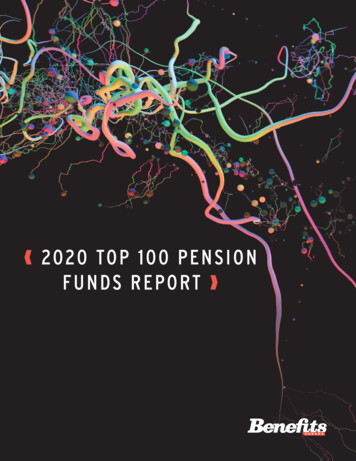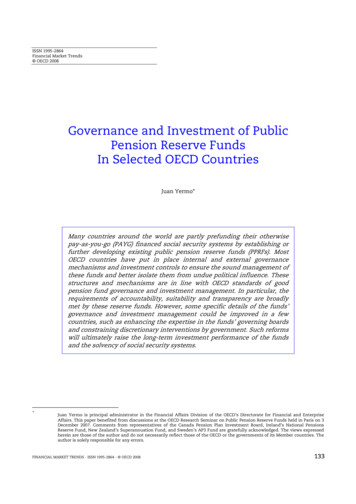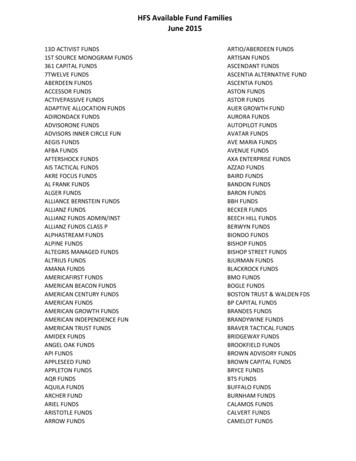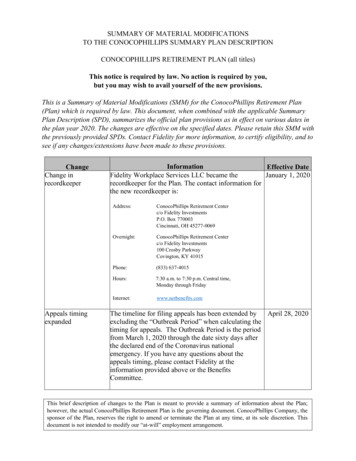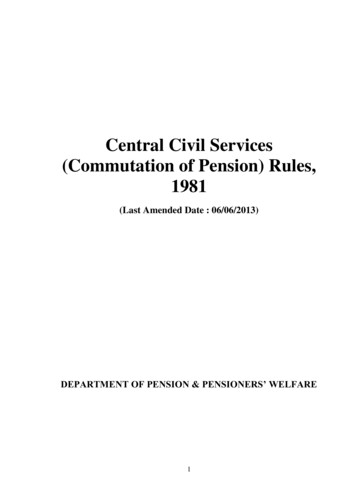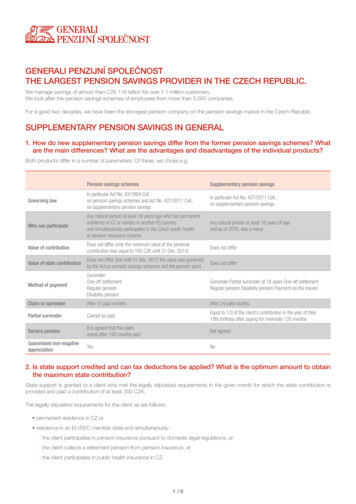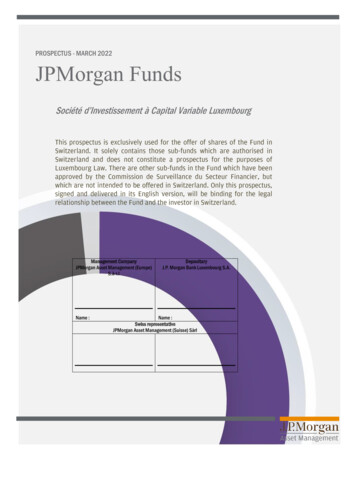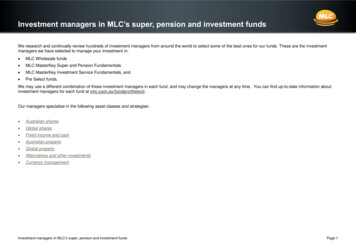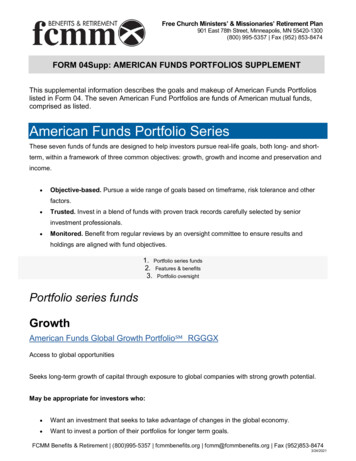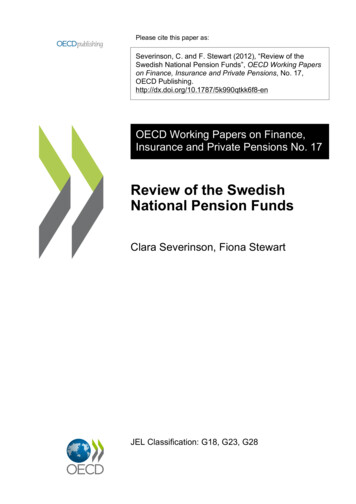
Transcription
Please cite this paper as:Severinson, C. and F. Stewart (2012), “Review of theSwedish National Pension Funds”, OECD Working Paperson Finance, Insurance and Private Pensions, No. 17,OECD enOECD Working Papers on Finance,Insurance and Private Pensions No. 17Review of the SwedishNational Pension FundsClara Severinson, Fiona StewartJEL Classification: G18, G23, G28
OECD WORKING PAPERS ON FINANCE, INSURANCE AND PRIVATE PENSIONSOECD Working Papers on Finance, Insurance and Private Pensions provide timely analysis andbackground on industry developments, structural issues, and public policy in the financial sector, includinginsurance and private pensions. Topics include risk management, governance, investments, benefitprotection, and financial education. These studies are prepared for dissemination in order to stimulatewider discussion and further analysis and obtain feedback from interested audiences.The papers are generally available only in their original language English or French with a summary in theother if available.OECD WORKING PAPERS ON FINANCE,INSURANCE AND PRIVATE PENSIONSare published on www.oecd.org/daf/fin/wpThis document and any map included herein are without prejudice to the status of or sovereignty over anyterritory, to the delimitation of international frontiers and boundaries and to the name of any territory, city or area.Ce document et toute carte qu'il peut comprendre ne préjugent en rien du statut de tout territoire, de lasouveraineté s’exerçant sur ce dernier, du tracé des frontières et limites internationales, et du nom de tout territoire,ville ou région. OECD 2012Applications for permission to reproduce or translate all or part of this material should be made to: OECD Publishing,rights@oecd.org or by fax 33 1 45 24 99 30.2
AbstractREVIEW OF THE SWEDISH NATIONAL PENSION FUNDSAbstract: This paper provides a review of the Swedish National Pension Funds based on internationalgood practice and OECD guidelines. The paper focuses mainly on the general size and structure of thefunds, the investment framework and the governance of the funds. The internal management of the fundsappears to be strong, with governance and risk management structures in place that appear to broadlyfollow OECD guidelines.The report concludes that the AP funds could benefit from having one clear and specific long-terminvestment objective, set by an independent committee answerable to Parliament, for all the AP fundsagainst which their long-term performance can objectively be measured. The mandate and role of the AP6fund could also be clarified.The report recommends the implementation of the prudent person rule as restrictive investmentregulations are leaving the AP funds with less room to adopt varying investment strategies, and thus takesaway some of the potential benefits of competition and diversification from having four different funds.Finally the selection process for the Governing Boards of the funds could be made more transparent andrigorous.JEL codes: G18, G23, G28Key words: pension funds, public pensions, reserve funds, governance, Swedish National Pension Funds,AP Funds, investment framework3
RésuméEXAMEN DES FONDS NATIONAUX DE PENSION EN SUEDERésumé : On trouvera dans cette note un examen des fonds nationaux de pension en Suède fondé surles bonnes pratiques menées dans les différents pays et les Lignes directrices de l‟OCDE. La note metprincipalement l‟accent sur le montant observé en général et sur la structure des fonds, le cadre desinvestissements et la gouvernance des fonds. La gestion interne des fonds apparaît saine, et il semble queles structures de gouvernance et de gestion du risque qui sont applicables soient conformes dansl‟ensemble aux Lignes directrices de l‟OCDE.L‟étude conclut que les fonds AP gagneraient à se fixer un objectif à long terme d‟investissement clairet spécifique, déterminé par une commission indépendante responsable devant le Parlement, pour tous lesfonds AP par rapport auxquels leurs performances à long terme peut être objectivement mesurées. Lemandat et le rôle du fonds AP6 pourraient également être clarifiés.Cette étude recommande l‟application de la règle de prudence, dans la mesure où des réglementationsrestrictives en matière d‟investissement laissent peu de marge de manœuvre aux fonds AP pour faire varierleurs stratégies d‟investissement et les privent donc des avantages potentiels de la concurrence et de ladiversification qui résultent de l‟existence de quatre fonds différents. Enfin, le processus de sélection desmembres des comités directeurs des fonds pourrait être rendu plus transparent et plus rigoureux.Codes JEL : G18, G23, G28Mots clés : fonds de pension, pensions publiques, fonds de réserve, gouvernance, fonds nationaux depension suédois, fonds AP, cadre d’investissement4
SammanfattningÖVERSYN AV DE SVENSKA AP-FONDERNASammanfattning: Denna studie ger en översikt av de svenska AP-fonderna baserat på internationellpraxis och OECD: s riktlinjer. Studiens fokus ligger på ett övergripande plan och behandlar nuvarandestorlek och struktur av AP-fonderna, ramarna för kapitalförvaltningen och fondernas styrning. Fondernasinterna förvaltningsorganisation verkar vara starka med en effektiv styrning av och god riskhantering i linjemed OECD‟s riktlinjer.Rapporten konstaterar att AP-fonderna skulle dra nytta av att ha ett tydligt gemensamt mål för allaAP-fonderna mot vilka de långsiktiga resultaten kan mätas på ett objektivt sätt. Målet bör fastställas av enoberoende kommitté ansvarig inför parlamentet, Sjätte AP-fondens roll i pensionssystemet och dessförvaltningsuppdrag bör också förtydligas.Rapporten rekommenderar att ersätta placeringsrestriktionerna i lagen med en aktsamhetsprincip dånuvarande regler minskar AP-fondernas utrymme till flexibilitet att vidta olika investeringsstrategier.Därmed går en del av de potentiella fördelarna med konkurrens och diversifiering från att ha fyra olikafonder förlorad. Slutligen kan urvalsprocessen för fondernas styrelser tydliggöras och bli mer strikt.JEL-koder: G18, G23, G28Nyckelord: pensionsfonder, offentliga pensioner, reservfonder, styrning, Sveriges pensionsfonder, APfonder, investeringsram5
TABLE OF CONTENTSEXECUTIVE SUMMARY .7INTRODUCTION .10STRUCTURE, SIZE AND OPERATING COSTS OF THE FUNDS .11Multi-Fund Structure of the AP Funds .11Size of Funds .11The Level of Costs .13Political Interference .15INVESTMENT FRAMEWORK.17Mandate and High-Level Objectives: AP funds 1 to 4 .17Investment Policy .21Prudent Person Rule.22The Sixth AP Fund .24GOVERNANCE ISSUES .26Autonomy of the Governing Body .27Membership and Selection of the Governing Body .28Governing Board Nominations .30CONCLUSION .32REFERENCES .33WORKING PAPERS PUBLISHED TO DATE .35TablesTable 1.Table 2.Table 3.Table 4.Table 5.Size of public pension reserve fund markets in selected OECD countries and other majoreconomies, 2010 .12Mandates and Investment Objectives of Public Pension Reserve Funds .17Current Investment Objectives of AP Funds 1 to 4 .19Management entities and governing bodies of reserve funds.27Summary of Board Nomination Process .28FiguresFigure 1.Figure 2.Figure 3.Figure 4.Size of public pension reserve fund markets in selected OECD countries and other majoreconomies, vs. Stock Market Capitalization 2010 .13Total pension funds and pension reserve funds‟ investment management costs in selectedOECD countries, 2010 (as a % of assets under management) .14Considerations relating to AP Funds‟ Role in Swedish Pension System .21Asset allocation of public pension reserve funds in selected OECD and non-OECDcountries, 2010 .246
EXECUTIVE SUMMARYThe OECD has been requested by Sweden‟s National Pension Fund Inquiry to provide high-levelguidance as to international experiences and good practices in relation to the Inquiry‟s review of the Firstthrough Fourth National Pension Funds (AP1 through AP4) and the Sixth National Pension Fund (AP6).The Inquiry has been tasked by the Swedish government to look at a number of both broader andspecific issues such as the overall strategic investment objectives of the funds, whether the existinginvestment restrictions on the funds are appropriate, the level of efficiency of the current fund structure,board member requirements, accounting and auditing of the funds and scope and timing of governmentevaluations.This paper summarizes the OECD‟s proposals for the Inquiry‟s consideration. The paper does notattempt to answer all of the questions posed by the Swedish government to the Inquiry, but rather presentsan international perspective on some of the broader, key issues based on OECD Member Countryexperiences and OECD good practices. The comments made in this paper focus mainly on the general sizeand structure of the funds, the investment framework and the governance of the funds.On a combined basis, the Swedish AP Funds are large compared to public pension reserve funds inmost other countries, although significantly larger funds exist in the United States, Japan Norway, SaudiArabia and Korea. The internal management of the AP funds appears to be strong with governance and riskmanagement structures in place (including experienced leadership and engaged board members) thatappear to broadly follow OECD guidelines.Sweden‟s four-fund structure is unique among global pension reserve funds. One of the mostcontentious issues to be examined by the Inquiry is whether the four-fund structure has been effective. Theoriginal idea behind the design of the AP funds as four distinct and independently operated entities was toreduce the impact of the funds on the domestic market, diversify management risk, enhance performancethrough competition and to mitigate the risk of political interference (Björkmo and Lundbergh, 2010), aswell as to diversify strategic risks. Arguments against a multi-fund structure have tended to focus on thelevel of costs, potential for economies of scale from having a smaller number funds, consolidatingexpertise and the number of board members, as well as potentially stronger governance and greaterresilience from outside influence from having one large fund rather than several smaller funds.The OECD has no strong view as to whether the current number of funds or fewer funds is optimaland leaves this to the Inquiry and the Swedish government to establish. However, it should be noted thatthe other reserve funds around the world do not seem to encounter major difficulties operating on acentralized basis. In terms of operating costs, the AP funds 1 to 4 do appear to be in line with theirinternational peers, even on a disaggregated basis, and low compared to the aggregated operating costs oftraditional pension funds in OECD countries. It is important to note that the risk of political interference ofreserve funds is pervasive especially in times of economic distress. Having a multi-fund structure maywork to increase the independence of the funds‟ operations, yet on the other hand, the visibility of onelarge fund as opposed to several small funds may also serve to protect it from outside influence. The risk ofpolitical interference is, however, not necessarily tied to the number of funds. Finally, it is important tonote that strong governance and oversight structures are powerful measures in mitigating political risk, butcannot altogether eliminate it.The over-arching investment mandate of the AP Funds 1 to 4 encoded in Swedish law is to provide ashigh investment return as possible, while not taking undue risk. The funds must also be in a position to payout benefits if requested by the Swedish Pensions Agency. The actual interpretation of this mandate is left7
to each of the funds, and the resulting investment objectives are disparate and inconsistent. The lack of adistinct, specific and long-term investment objective that is consistent across the funds has meant that thefunds‟ performance has had no clear and objective target against which their performance could bemeasured.A more powerful, consistent and specific investment mandate across the AP funds that is approved byParliament would help make the evaluation of their performance more transparent and easier to establish.This investment objective could be expressed in terms of a targeted funding ratio, cash outflow scheduleand a long-term real rate of return target and would serve to keep the funds answerable to the electorate ona more objective basis. Furthermore, changes to the funds‟ structure based on future reviews may be morereadily motivated based on such an objective measurement, as could it help to protect the funds againstundue political pressure.Our main suggestions for consideration by the Inquiry Board are summarised as follows: Establish an independent committee that is responsible for issues related to the AP funds:This independent committee should be answerable to Parliament (and could, for instance,potentially be a part of or an extension of the current parliamentary Pensions Group). Its rolewould be to “own” issues related to the AP funds, such as establishing the over-archinginvestment objective, establishing performance measurement criteria, nominating boardmembers. The committee could also serve to promote public awareness of the role of the APfunds within the Swedish pension system. Establish one targeted and measurable long-term investment objective for all the AP funds:One clear and specific long-term investment objective should be set for all the AP funds againstwhich their long-term performance can objectively be measured. This over-arching and long-terminvestment objective should have Parliamentary approval. It should be clearly expressed andcould directly take into account the expected timing and amounts of the cash in- and out-flows ofthe AP funds, the expected financial impact of demographic changes, the long-term fundingtarget of the funds in relation to the pension system‟s liabilities and the level of expectedinvestment return versus the acceptable level of risk that the balancing mechanism would betriggered and pensioner benefits cut. Measure performance against this long-term investment objective: Currently, theperformance of the funds seem to be mainly measured in relation to each other and based on thelevel of their annual operating costs (which appear to be low if compared internationally). Thisappears largely to be due to the lack of a clear and specific investment objective that would applyconsistently to all the AP funds. Performance should primarily be measured directly against anover-arching and long-term investment objective, as described in the bullet point above. Implement the Prudent Person Rule: As a general principle, the OECD supports theimplementation of the prudent person rule. If the goal is to reduce risk, then this can be donespecifically in the over-arching investment objective described above and in the strict governanceand oversight of the funds rather than via specific investment restrictions. Such restrictions couldin fact lead to suboptimal portfolios and over-exposure to certain types of assets. Furthermore,restrictive investment regulations leaves the AP funds with less room to adopt varying investmentstrategies, and thus takes away some of the potential benefits of competition and diversificationfrom having four different funds. The implementation of a less restrictive investment frameworkshould furthermore be supported in each fund by a written investment policy describing primarilyhow each fund would intend to meet the over-arching investment objective and their strategicasset allocation policies.8
Clarify the mandate of the AP6 Fund and align the governance and operation of the fundwith that mandate: The mandate of the AP6 fund is to invest its assets in the Swedish privateequity market, within the framework for what is in the best interest of the pension system.Unlisted assets and other alternative investments can be an important investment class forpension funds. However, it is unclear to what extent such investments in and of themselves are inthe best interest of the pension system. If AP6 is to be maintained, then its role and importancewithin the pension system should be clarified. As investment in unlisted assets takes expertiseand specialisation, one potential option could be to embed the AP6 fund and its exposure tounlisted assets within the other AP funds. Any investments made by AP6 would then need to bemotivated within the overall framework of the Prudent Person Rule. Strengthen the selection process for the Governing Boards: The selection process of thegoverning boards of the AP funds currently appears to be ad hoc and not transparent. The OECDsupports implementing fit and proper criteria for board members, a balance of skills betweenmembers and a transparent and rigorous selection process. Furthermore, there appears to be noparticularly compelling reason to limit Governing Board members to Swedish citizens. BoardMember candidates would need to follow a transparent nomination process, and meet pre-definedfit and proper criteria for the Board in aggregate.The guidance and proposals made in this paper draw on previous work done by the OECD and arebased on international good practices identified in this previous work. In recent years, the OECD hasanalysed the governance and investment arrangements of public pension reserve funds around the worldand monitored their investment performance in the OECD‟s annual Pension Markets in Focus newsletter.The basis for the proposals made in this paper is the OECD‟s Core Principles of Occupational PensionRegulation and the associated guidelines on “Pension Fund Asset Management” and “Pension FundGovernance”. Particularly relevant to this review is the OECD‟s 2008 report Governance and Investmentof Public Pension Reserve Funds in Selected OECD Countries. Furthermore, the OECD has done similarreviews for the pension reserve funds in Japan and Korea.9
INTRODUCTIONThe OECD supports the establishment of reserves to prefund social security benefits as these fundsallow governments to respond to the fiscal pressures from ageing populations (tax smoothing /improvingdebt position of the government) and international diversification can provide (long-term) exposure toother countries experiencing less of a demographic decline. However, the OECD also recognizes that suchfunds face some unique challenges as compared to traditional pension funds due to their size, their broadermandate and the sometimes difficult balance between political and economic considerations.The pension reserve system in Sweden has a unique structure in that it is divided into four separatefunds, known as AP1 through AP4. One quarter of the social security contributions made towards the statepension system are directed into each of these four funds. In turn, each of the four funds pays out onequarter of benefits due from the state pension system. In addition there is a separate AP6 fund whichinvests exclusively in private equity. The AP6 fund receives no contributions and pays no benefits.The AP7 fund relates to the mandatory individual pension savings accounts and is not subject to thecurrent Inquiry. No further mention of AP7 will be made in this paper.Based on our interviews, it is our understanding that the AP Funds 1 through 4 have no formalobligations with respect to future pension payments, but can be called on by the Pensions Authority tomake payments due. In effect, the funds act to an extent as a “clearinghouse” for cash flows in the statepension system, where on a monthly basis, one quarter of contributions into the state pension system aredeposited into each of the funds and one quarter of payments due are paid out of each fund. Any excess ofcontributions in over payments out would remain in the funds and any shortfall would be a loss to thefunds.As of year-end 2011, the total assets in the AP Funds 1 through 4 plus AP Fund 6 was SEK 873billion which is equal to 12% of the total liabilities of the state pension system (Pensionsmyndigheten,2010). Over the coming thirty years due to mainly demographic changes, the payments to be made fromthe pension system are expected to significantly outsize the payments to be made into the system and by2040, the size of the buffer funds AP1 to 4 and 6 is expected to have decreased to SEK 400 billion(Ministry of Finance, 2011).10
STRUCTURE, SIZE AND OPERATING COSTS OF THE FUNDSMulti-Fund Structure of the AP FundsSweden is unique in that it is the only country which utilizes a structure of multiple pension reservefunds. The multiple fund structure was originally set up for the following reasons (Björkmo andLundbergh, 2010): To reduce market impact; To diversify management risks; To allow competition to reduce costs and improve performance; and, To reduce political interference.Four identical funds were also established to diversify strategic risks (hence the intension that theBoards should independently set the goal and decide on asset allocation) – as described in the AP-fundlegislation.1Historical factors appear to have played a part in the creation of the multi-fund structure, as well. Thesingle pension reserve fund that was the predecessor to the AP funds had several boards that weretransformed into the boards of the AP funds 1 to 4 at their creation. Furthermore, the AP6 fund received itsassets from a portion of the disbanded wage-earners funds (“löntagarfonder”) that existed in the 1980‟s andconsisted mainly of pooled profits from Swedish corporations (Whyman, 2004 and Björkmo, 2009).The question has been raised by the Inquiry as to whether the current structure of four AP funds plusthe AP6 fund should be maintained? Obtaining economies of scale could argue for a smaller number offunds, whereas the risk of concentration of power and market impact could argue for several smaller andindependently operated funds. Whether the multi-fund structure has achieved the four goals as listedabove, and the relative importance of these four goals, will be left to the Inquiry Board and the SwedishParliament to establish.From an international perspective, other reserve funds around the world have either not specificallyidentified the four goals listed above in relation to having a single fund versus several funds, or they haveapproached these challenges in different ways.Size of FundsThe size of the National Pension Funds in Sweden is large in absolute terms and as a percentage ofGDP - with only the Saudi Arabian and Norwegian funds representing significantly higher percentages ofGDP, with the Japanese and Korean funds being on a par.1Prop.1999/2000:46 p.116-12111
Table 1. Size of public pension reserve fund markets in selected OECD countries and other majoreconomies, 2010CountryName of the fund or institutionEstablished inSelected OECD countriesUnited StatesSocial Security Trust FundJapan (1)Government Pension Investment FundKoreaNational Pension FundCanadaCanadian Pension PlanSwedenNational Pension Funds (AP1-AP4 and AP6)SpainSocial Security Reserve FundAustraliaFuture FundFrancePension Reserve FundIrelandNational Pensions Reserve FundBelgiumZilverfondsNorwayGovernment Pension Fund - NorwayPortugalSocial Security Financial Stabilisation FundNew Zealand (2)New Zealand Superannuation FundChilePension Reserve FundMexicoIMSS ReservePolandDemographic Reserve FundTotal selected OECD countries (3)Other major economiesSaudi ArabiaGeneral Organisation for Social Insurance (1,4)ChinaNational Social Security FundArgentinaSustainability Guarantee FundTotal other major economies (3)Memo item: Sovereign Wealth Funds with a pension focus (5)NorwayGovernment Pension Fund - GlobalRussian Federation National Wealth Fund1940200619881997 (CPPIB)/ 1965 002USD billionsAssets% of GDP% urce: Pension Markets in Focus, July 2011The trend around the world is for pension funds (not just reserve funds) to get larger and indeedgovernment and regulatory authorities have been finding ways to encourage this trend. For example in theUnited States pension funds have been working together to gain economies of scale, whilst in Canada andthe Netherlands large funds (such as OMERS in Canada and PGGM in the Netherlands) are now allowedto compete for external assignments. Centralizing is coming to the UK with the introduction of the NEST(National Employment Savings Trust) system, whilst in Australia the licensing of trustees caused thenumber of superannuation funds to decline. It should also be noted that mandatory systems in countrieswith less developed capital markets (such as in Latin American and Eastern Europe) operate with only ahandful of large funds.As a percentage of stock market capitalisation, the AP funds in combination represent a relativelylarge level of stock market capitalisation which would highlight the importance of internationaldiversification to their portfolios to reduce their potential dominance on the Swedish markets. The APfunds are, however, significantly smaller when compared to the relative size of some of the other reservefunds around the world (notably the Irish and the Asian pension reserve funds).12
Figure 1. Size of public pension reserve fund markets in selected OECD countries and other majoreconomies, vs. Stock Market Capitalization 2010Reserve Fund Assets as a Percent ofNational Stock Market Capitalisation as of year-end 201060%50%40%30%20%10%0%IrelandJapanKoreaUnited States Sweden AP1NorwaySpain SocialCanadianAustraliaPolandChile Pension Mexico IMSSNationalGovernmentNationalSocialAP4 and AP6 GovernmentSecurityPension Plan Future Fund Demographic Reserve Fund ReservePensionsPension Pension Fund Security TrustPension Fund Reserve FundReserve FundReserve Fund InvestmentFundFundSource: OECD Global Pension Statistics and the World Federation of ExchangesOther public pension reserve funds have found different ways to reduce their potential market impact.For example, the Norwegian reserve fund has, for example, split its fund into a domestic and aninternational component in order to reduce market impact.Meanwhile, in the United States Social Security Trust Fund has invested exclusively in US Treasuryobligations backed by the full faith and credit of the US government. Some critics, however, havequestioned whether this funding from within the US government for US government obligations amountsto true additional security for pensioners (Buffin Partners, 2011).The Level of CostsIn 2010, the OECD received self-reported data on operating costs from AP 1, 3 and 4 as well as frompension reserve funds in some other countries. Based on the data received, the operating costs of the APfunds appear to be in the middle of the range compared to the operating costs of public pension reservefunds in other OECD countries.In 2010, the
The OECD has been requested by Swedens National Pension Fund Inquiry to provide high-level guidance as to international experiences and good practices in relation to the Inquiry¶s review of the First through Fourth National Pension Funds (AP1 through AP4) and the Sixth National Pension Fund (AP6).
